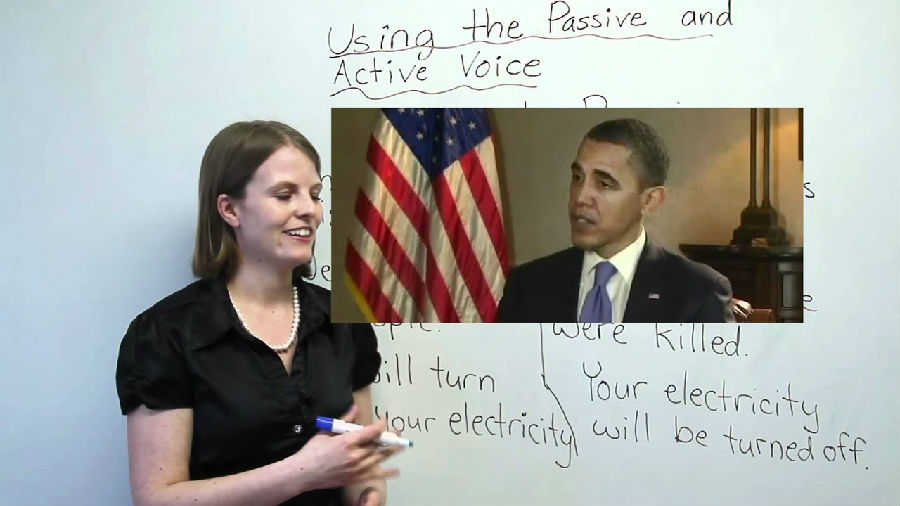Hi my name is Emma and today we will be talking about using the passive voice and the active voice.
大家好,我是Emma,今天我们要讲的是被动和主动语态的使用。
So what this lesson is going to do is, it's going to look at first of all, what is the difference between the passive and the active voice,
本期课程要做的是什么呢?首先,我们要讲的是被动和主动语态之间的区别,
something that a lot of ESL students do have problems with, and then we're going to look at how they are used and when to use them.
很多英语非母语的学生都分不清它们之间的区别,然后我们要学习如何以及何时使用。
So this lesson is really going to focus on how businesses can use the active and passive voices,
所以本节课重点关注企业、政府如何使用它们,
how governments use them and which ones will your teachers prefer
以及在写论文或不同的书面作业时,
when you write essays or when you write different written assignments. Okay so let's get started.
老师们更喜欢哪一种语态。好了,现在开始。
So first of all, I have here a sentence, 'I ate cake.' 'I ate cake' is an example of the active voice.
所以首先,我在这里写了一个句子,‘I ate cake’。‘I ate cake’是主动语态。
Most sentences you see our examples of the active voice. What it is is you have a subject 'I',
大多数例句都是主动语态。首先要有一个主语‘I’,
you have the verb, the action 'ate' and then for a lot of sentences you have the object, in this case 'cake'.
然后是动词‘ate’,很多句子里还有宾语,这里的宾语是‘cake’。
So what is an active voice? What does it do? Well, it's where the subject does the action: who ate the cake? I ate the cake.
所以什么是主动语态呢?主动语态的作用是什么?主语做出了某种动作时会用到:谁吃了蛋糕?我吃了蛋糕。
Who did the action? I did the action, okay? So now let's compare two, sorry, let's compare this to the passive voice.
是做出了这一动作?我做出了这个动作。我们把主动和被动语态进行对比。

So here in this example we have most of the same structures, we have the cake, it's a cake, cake.
这个例子的结构都差不多,我们这句子里有‘cake’,
We have the verb 'to eat'. Now we have the verb 'to be was'. So this is an example of the passive voice. So 'The cake was eaten'.
我们有动词‘to eat’。这里我们的动词是‘to be was’。所以这是句子是被动语态。所以组成了‘The cake was eaten’。
Now how do we make the passive voice? Well we take the passive subject. What does that mean?
那么怎么组成被动语态呢?我们需要被动主语。这是什么意思?
Well, in this case, the cake is not doing the action; in the first case, we say I am doing the action;
在这个例句中,‘cake’不是做这个动作的主语;在第一个句子中,‘I’是做这个动作的主语;
in the second sentence, we don't know who is doing the action. We just know that the object of the action 'the cake' is being eaten.
在第二个句子中,我们不知道是谁做了这个动作。我们只知道这个动作的宾语‘the cake’被吃掉了。
So we've sort of taken away the subject. There is no 'I' in the sentence, you don't know who is eating the cake.
所以我们抽掉了这个句子的主语,句子里没有‘I’,我们不知道谁吃了蛋糕。
So in order to make the passive, here is our formula we take the passive subject so in this case that's the cake, the cake in the first sentence
所以要组成被动句,我们有一个公式,选择一个被动主语,在这个句子里是‘the cake’,
We take 'to be', so 'was' and the past participle which in this case is 'eaten'.
需要‘to be’,所以选择‘was’,过去分词是‘eaten’。
Now for the active voice in the passive voice it's very important to remember that we can use this with so many different tenses.
在主动和被动语态中,可以使用多种不同的时态。
So for example, we can use it with the present perfect, the future,
例如,我们可以用现在完成时、将来时,
the main thing to remember is the passive voice always has to be past participle.
但要记住,被动语态一定要用过去分词。
So we're going to go into more detail now about how the passive voice and the active voice are used and go through more examples of both voices.
现在我们要详细讲一讲被动和主动语态的使用方法,再看几个相关的例句。
Look at how we can use the passive and the active. So here is a comparison chart.
先看看被动和主动语态的使用方法。这里有一个对照表。
On the one side, we have the active voice, so notice we have a subject: I, we, we;
一边是主动语态,所以有主语:I/we/we;
whereas on the passive, we have: be, was, were, will be. So just take a second look at the differences between these sentences.
而被动语态这边有:be/was/were/ will be。仔细看看这些句子之间的区别。
They have the same meaning. It's just the emphasis is on something different. So read both sides of the chart and just think about it for a second.
它们意思相同,只是强调的重点不同。读读两边的句子,仔细想一想。











